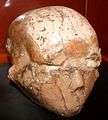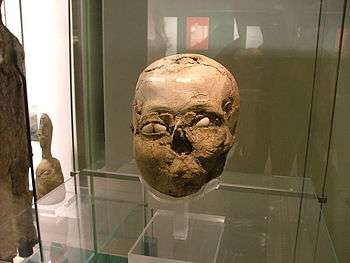Plastered human skulls
|
Plastered human skull from Jericho on display in the British Museum | |
| Material | Plaster and Bone |
|---|---|
| Size | 20.3 cm high |
| Created | 7000-6000 BC |
| Present location | British Museum, London |
| Registration | ME 127414 |
Plastered human skulls are reconstructed human skulls that were made in the ancient Levant between 7000 and 6000 BC in the Pre-Pottery Neolithic B period. They represent some of the oldest forms of art in the Middle East and demonstrate that the prehistoric population took great care in burying their ancestors below their homes. The skulls denote some of the earliest sculptural examples of portraiture in the history of art.
Discovery
One skull was accidentally unearthed in the 1930s by the archaeologist John Garstang at Jericho in the West Bank. A number of plastered skulls from Jericho were discovered by the British archaeologist Kathleen Kenyon in the 1950s and can now be found in the collections of the British Museum, the Ashmolean Museum, the Cambridge Museum of Archaeology and Anthropology, the Royal Ontario Museum, the Nicholson Museum in Sydney and the Jordan Archaeological Museum.[1]Other sites where plastered skulls were excavated include Ain Ghazal and Amman, Jordan, and Tell Ramad, Syria.[4] Most of the plastered skulls were from adult males, but some belonged to women and children.
Archaeological significance
The plastered skulls represent some of the earliest forms of burial practices in the southern Levant. During the Neolithic period, the deceased were often buried under the floors of their homes.[4] Sometimes the skull was removed, and its cavities filled with plaster and painted. In order to create more lifelike faces, shells were inset for eyes, and paint was used to represent facial features, hair, and moustaches.[4][5] Some scholars believe that this burial practice represents an early form of ancestor worship, where the plastered skulls were used to commemorate and respect family ancestors.[4] Other experts argue that the plastered skulls could be linked to the practice of head hunting, and used as trophies. Plastered skulls provide evidence about the earliest arts and religious practices in the ancient Near East.
Gallery
 Jericho skull in the Jordan Archaeological Museum
Jericho skull in the Jordan Archaeological Museum Another plastered skull from the set in the Ashmolean
Another plastered skull from the set in the Ashmolean Nicholson Museum skull from Jericho
Nicholson Museum skull from Jericho- Skull from Beisamoun on exhibition at the Moshe Stekelis Museum of Prehistory
Further reading
- D. Collon, Ancient Near Eastern art (London, The British Museum Press, 1995)
- J.N. Tubb, Canaanites (London, The British Museum Press, 1998)
- German, Senta. “The Neolithic Revolution.” Khana Academy.
- Strouhal, E. Five Plastered Skulls from Pre-Pottery Neolithic B Jericho: Anthropological Study Paléorient 1:1-2 (1973): 231-247.
- Mazar, Amihai (1990). Archaeology of the land of the Bible (1st ed.). New York: Doubleday. ISBN 038523970X.
